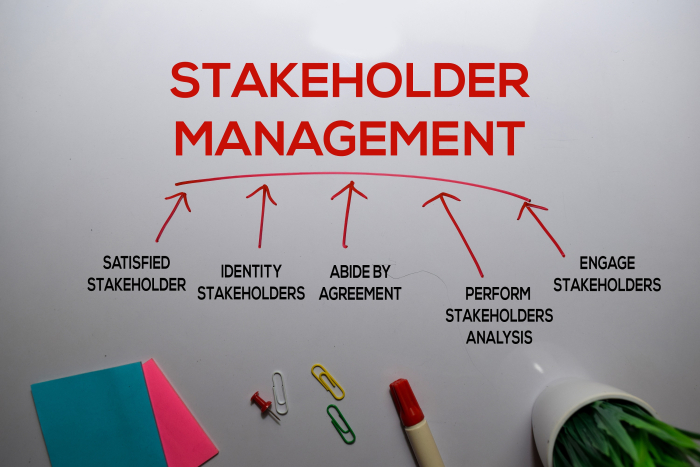
 Data Structure
Data Structure Networking
Networking RDBMS
RDBMS Operating System
Operating System Java
Java MS Excel
MS Excel iOS
iOS HTML
HTML CSS
CSS Android
Android Python
Python C Programming
C Programming C++
C++ C#
C# MongoDB
MongoDB MySQL
MySQL Javascript
Javascript PHP
PHP
- Selected Reading
- UPSC IAS Exams Notes
- Developer's Best Practices
- Questions and Answers
- Effective Resume Writing
- HR Interview Questions
- Computer Glossary
- Who is Who
Stakeholder Analysis and Stakeholder Management
A project manager incontrovertibly wears multiple hats during the course of a project and one of the most demanding roles out of the many would arguably be that of a liaison. Having to be the mediator between multiple people is not an easy task especially when each of the individuals involved holds variable interests within the same project. These individuals having an interest in the project are stakeholders and may or may not influence the performance of the project based on the role they play within the project. Therefore it is highly important that a project manager undertake stakeholder analysis and management in a project.
Who are the Key Stakeholders in a Business?

The key stakeholders in a business are the people or groups that have an interest in its success or failure. Every business has a number of stakeholders, such as employees, shareholders, customers, suppliers, and the community in which it operates. It's essential to identify the key people or groups who have an interest in the business and consider how each stakeholder's needs might be met in order to encourage their support and loyalty. The stakeholders for a project may include ?
Project sponsor
Project team members
Stakeholders outside of the project team
Suppliers (e.g., contractors)
Customers (e.g., end users)
Regulatory bodies
It is important to note that stakeholders are not limited to those who are on a project team. They include anyone who will be influenced by or have some impact on the project. This includes the sponsor, funding agency, customers and potential customers, employees of sponsoring organization, management of sponsoring organization, employees of any other organization involved in the project (for example subcontractors), suppliers of materials and services required for the project, competitors in this area of business or with similar products or services as those being produced by the sponsoring organization.
As such, stakeholders are often divided into three categories: internal, external, and community. Internal stakeholders are those who work for the same company as you do; external stakeholders are those outside your company; and community stakeholders are those who live near your organization's office location. Some other examples of stakeholder groups include shareholders, employees, customers, suppliers, regulators, contractors, and communities that may be affected by the project.
What is Stakeholder Analysis?
Stakeholder analysis is a process of identifying stakeholders, understanding their interests and concerns, determining the best ways to manage them, and implementing strategies to satisfy their interests. The stakeholder analysis process begins with understanding who the stakeholders are. This includes not just the project's key sponsors but also those who will be impacted by it. Stakeholders can range from individuals and groups to organizations.
It also involves the process of identifying and analyzing the potential impact of each stakeholder on the project or even the organization. Stakeholders are individuals or groups who can affect or be affected by the achievement of the project objectives. The success of a project is dependent on how well stakeholders are involved in the process. Thus through stakeholder analysis, the effects of the people, groups, and organizations on a project and also their need for the project's successful completion are examined.
What are Some of the Methods Used for Stakeholder Analysis?
There are quite a few tools, methods, and advanced software that are designed for improved, efficient, and aided stakeholder analysis and stakeholder mapping. As with any other analysis, stakeholder analysis also starts with collecting information about the stakeholders -
"Who are the stakeholders?"
"What is their position in the organization?"
"What role are they playing in the project?"
"What are their needs?"
"What are their priorities?"
"What are their expectations?"
"What outputs do they require from the project and when and how?"
These are a few of the information that will help a stakeholder manager to better manage the stakeholders throughout the projects. Instead of relying on one perspective, it would be even more effective if the stakeholder manager or the project manager concludes the list of stakeholders with the help of other relevant members. This can be done by brainstorming with other project managers or people with expertise in the subject of the project. Two of the other well-practiced methods that are helpful for stakeholder analysis are ?
RACI Matrix - The RACI matrix not only helps classify but also in forming an agreement or a protocol when it comes to the responsibility of each task. The matrix analyses and arrange people based on their accountability for a particular task. It categorizes stakeholders as Responsible, Accountable, Consulted, and Informed.
Affinity Diagram - Affinity diagrams can be used to classify stakeholders through brainstorming, grouping, and assigning based on roles, responsibilities, or interests.
What is Stakeholder Management?

Stakeholder management is a process of identifying, analyzing, and managing the needs and expectations of stakeholders in order to ensure that their needs are met. Stakeholder management is a crucial part of project management. It is important to know and understand the needs and wants of all stakeholders in order to deliver a successful project. The role of the stakeholder manager, often delivered by a project manager is to orchestrate the cooperation between different stakeholders during a project. The project manager is responsible for managing, coordinating, and communicating with all stakeholders of the project. The stakeholder manager is responsible for identifying and understanding the needs of various stakeholders, as well as for communicating with them. The stakeholder management process includes five steps ?
Identify and understand the needs of various stakeholders
Communicate with them
Negotiate agreements
Manage expectations
Reach closure
How to Approach Stakeholder Management?
Not all stakeholders are the same - Even though it is within one single project, the range of stakeholders involved will be broad with different knowledge, perspectives, and experience hence it is important to manage the stakeholders differently. Mapping stakeholders to influence, interest and impact will help in this process.
Communication is key - Regular updates regarding the process and progress of the project are critical in maintaining the trust and support of the stakeholders. It is also important that the stakeholders understand what is required of them and where the project stands. This in turn validates their expectations of the roadmap and timeline of the projects in addition to their outcomes
Fact-based communication is even more important - Communication is encouraged among stakeholders as it is an opportunity to clear misunderstandings and misconceptions of even the tiniest details of the project such as deliverables and responsibilities. It is also important to communicate with evidence and data so that everyone understands the perspective and can provide additional support when necessary. It also provides transparency which is much required in the complicated environments of a project.
What are the Differences Between Stakeholder Analysis and Stakeholder Management?
Both Stakeholder management and stakeholder analysis are a process serving different roles but for the same purpose. While stakeholder management is the process of identifying, analyzing, and taking into account the interests of all stakeholders, stakeholder analysis is a technique for understanding stakeholder interests. In stakeholder management, organizations assign responsibilities to individuals in order to ensure that all stakeholders are taken care of. Whereas in stakeholder analysis, organizations analyze their stakeholders and identify their needs and priorities.
Conclusion
The project manager should have a solid understanding of the organization's culture and what values are important to them. They should also have knowledge about which stakeholders are most important to the organization so that they can focus on those in particular. In order to be successful in their role, a project manager needs to be able to identify and manage the risk of conflict between stakeholders that may arise during a project. They also need to know how best to address these issues through mitigation or avoidance strategies which is why it is important to establish a stakeholder management system by conducting a thorough stakeholder analysis, a project manager would be prepared for stakeholder management.

